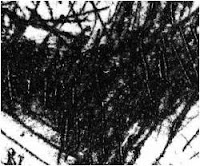 An etching begins by coating a copper plate with an acid resistant material such as wax. Once the ground is dry, the artist uses an etching needle to begin drawing a picture into the surface. Once the image is complete, it is dropped in an acid bath so that the acid will "bite" the exposed areas. The artist will then clean the plate, roll it with ink, and will put into a press. Numerous images can be formed this way.
An etching begins by coating a copper plate with an acid resistant material such as wax. Once the ground is dry, the artist uses an etching needle to begin drawing a picture into the surface. Once the image is complete, it is dropped in an acid bath so that the acid will "bite" the exposed areas. The artist will then clean the plate, roll it with ink, and will put into a press. Numerous images can be formed this way.
There are several types of etchings but drypoint etching is one of the most desirable in the market. The lines produced by printing a drypoint are formed not only by the depressions in the plate as discussed above but also by the burr, or raised lines at the edge of the incised lines. If examined under magnification, the incised lines look like depressions in the earth made with a plow while the raised lines look like the dirt thrown to the side of the depression. Once printed, the drypoint appears rich in tone and a bit fuzzy.

Dry point etchings such as this one are often highly sought after as the raised lines more quickly disappear after each impression, rendering a less and less desirable image after each pass.
Many drypoint etchings have a sepia tone as seen in this work.
3 comments:
COOL ARTS! It's worth appreciating. I wish I could also create like this. thank you and GOD Bless us always.
EPSON Ultra Premium Luster Photo Paper
Post a Comment